Estimated reading time: 6 minutes
Getting to know the different parts of your fruit tree makes everything else about fruit growing much easier.
For example, fruit tree anatomy is a very useful thing to know before you start making any pruning cuts. You definitely don’t want to accidentally remove all the fruit buds with overzealous pruning.
Getting to know the different parts of a fruit tree was one of the things we loved when we first came home to the farm. It helped us to avoid some costly pruning mistakes!
Tips to spot fruit buds vs. leaf buds easily
If you do a lot of pruning like we do, it becomes very easy to spot the difference between different bud types. But if you’re only pruning occasionally it might be something you need to learn.
One of the mistakes we see regularly is people accidentally cutting fruit buds off. It’s very easy to avoid this problem with some clear pruning instructions.
So it’s important that you feel confident in identifying fruit buds, and spring is the perfect time to be on the lookout.
If you pay attention you’ll be able to watch the buds slowly wake up and then reveal either a leaf or a flower. And it all happens over the space of a few short weeks.
It’s also pretty important to understand the difference between limbs, laterals, and spurs.
Do fruit buds and leaf buds look different?
Learning how to tell the difference between leaf buds and fruit buds confuses a lot of fruit growers, especially beginners.
In fact, many new fruit growers are not aware of the buds on their fruit trees at all. They’re often amazed when we show them that there’s a bud at the base of every single leaf.
The best way we can explain buds is to show them to you.
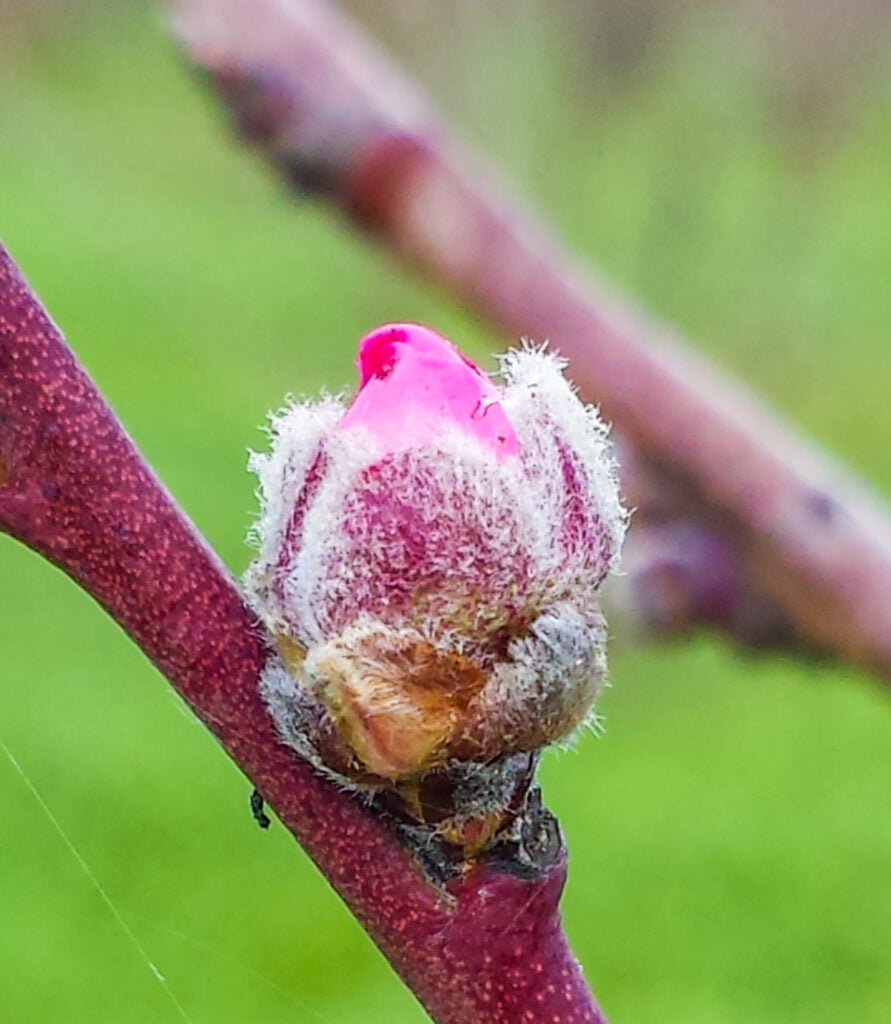
Some key differences to look for between leaf and fruit buds
Generally speaking, fruit buds are plumper and furrier than leaf buds.
Leaf buds tend to be slim, flat, and smooth.
It’s probably easiest to see this on peach and nectarine trees. The photo above shows a lovely fat and furry fruit bud on one of our peach trees. You can even see the pink flower petals showing through, which is a dead giveaway.
The apple shoot (below) also shows the difference. The terminal bud is a fat, furry fruit bud. Below that are leaf buds—you can see clearly that they are much flatter.
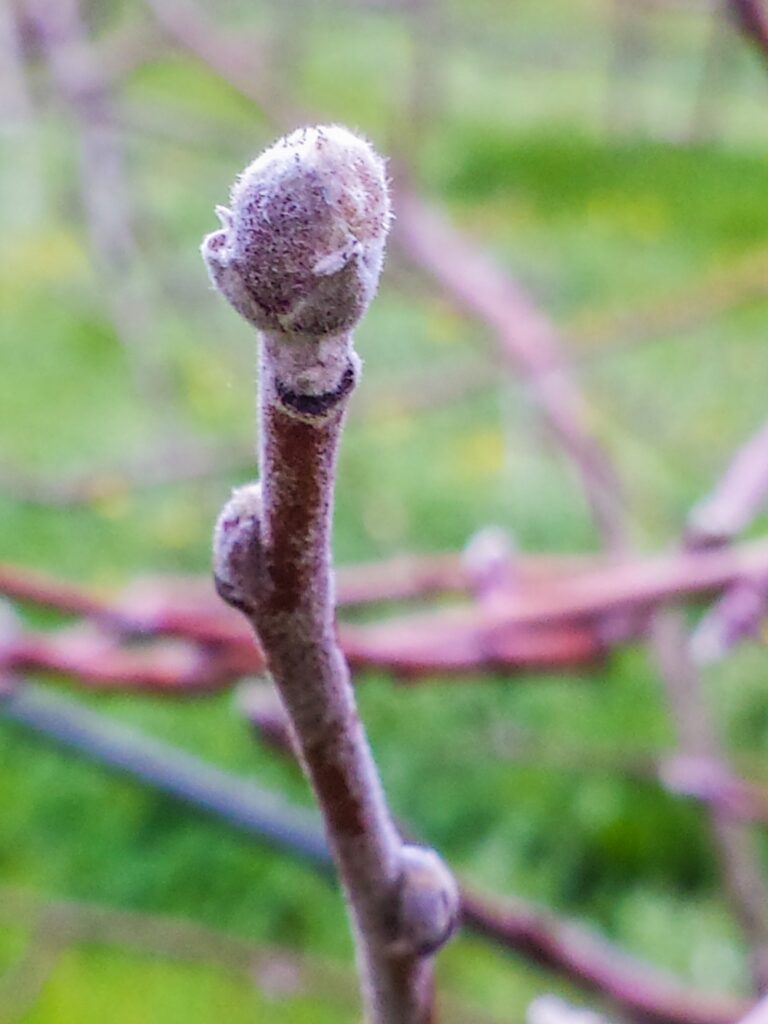
Peaches often have triple buds. These have a skinny leaf bud in the middle flanked by two fruit buds on either side, as you can clearly see in this photo.
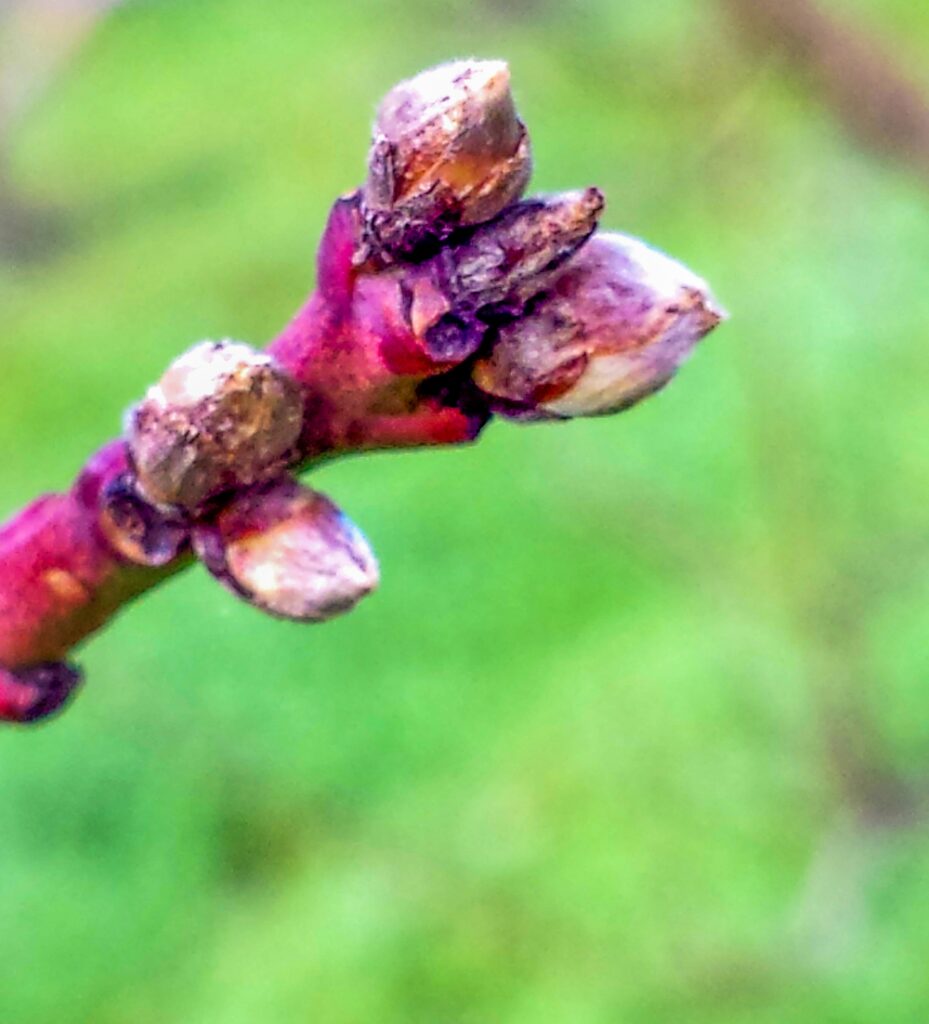
Buds on different types of fruit trees
The buds look a bit different on every fruit type. It’s harder to tell the difference between fruit buds and leaf buds on a pear tree, for example.
We’ve added coloured arrows to the photo of a pear tree (below) so you know what you’re looking at.
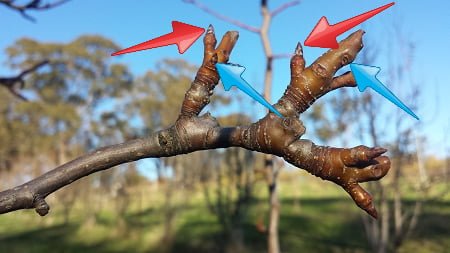
The red arrows indicate fruit buds and the blue arrows are pointing to leaf buds.
Even though it’s less distinct, you can once again see that there’s a clear difference in size and shape.
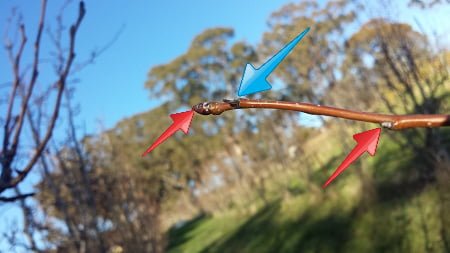
What is the difference between leaf and fruit buds?
The most simple explanation is that fruit buds produce flowers, which (usually) turn into fruit.
Leaf buds (which are sometimes called vegetative buds) grow leaves. Some of those vegetative buds may extend to become shoots. That’s why these buds are also sometimes called ‘growth buds’.
The shoots may remain as a bunch of leaves or may grow into spurs, laterals, or even branches. This depends on a few variables:
- where they are on the tree
- how you prune the tree
- how vigorously the tree is growing
- the type of fruit tree
- the age of the tree
How are fruit trees like people?
Fruit buds (also sometimes called flower buds) contain embryonic flower parts. The flower is the reproductive part of the plant and contains lots of parts that can help you identify different fruit types.
Flowers contain both male and female parts. In some fruit types they’re in the same flower, in others they’re in different flowers.
Surprisingly, there are a lot of ways that fruit trees and people are similar.
The first is that fruit trees reproduce sexually. This means that the ovary (deep inside the flower) needs to be fertilised by pollen. Some trees are self-fertile, but usually for fertilisation to occur the pollen must come from a different variety altogether.
Why do some buds turn into fruit buds?
Branches or laterals that are horizontal are more likely to form fruit buds. Vertical wood on the other hand is more likely to develop leaf (or growth) buds. The buds on the end of laterals—called apical buds—are likely to be fruit buds.
But what’s behind all of this?
Well, it’s all driven by hormones. It’s just one of the many things that fruit trees and humans have in common.
Related Articles
How to prune your apple tree
Pruning apple trees takes a little more specialist knowledge than other fruit types, but your trees will reward you with ample crops.
Taming monster fruit trees with renovation pruning
Learn how to use a technique called renovation pruning to tame large, unpruned, and out-of-control monster fruit trees.
How to plant a fruit tree – the easy way
Everything you need to know about how to plant your new fruit trees to get them off to a great start in life.

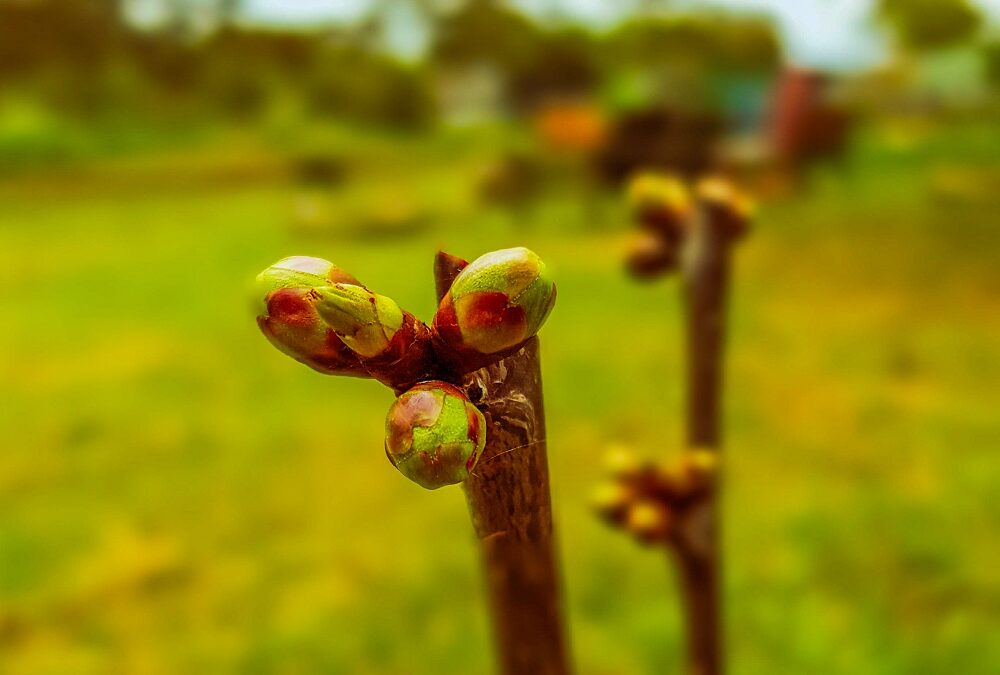

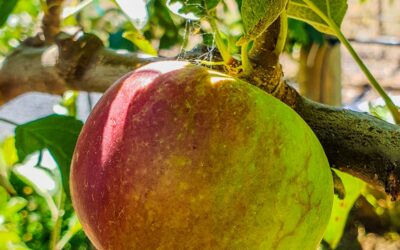
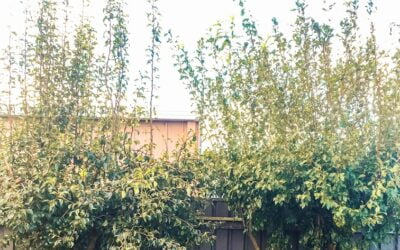



I live on the east coast of Tasmania. I purchased bare fruit nectarine and apple trees at the same time in June 2019. The Apple tree has taken off but the nectarine tree has not. The nectarine tree seems healthy enough, browny red trunk and limbs plus furry buds which look lifeless. Could it be a variety which is late to take off or is it in fact dead. The lemon, lime and quince trees near it are all flourishing.
Hi Susan, there’s an easy way to find out if the tree’s alive – just scratch the bark of the nectarine tree (with your secateurs or fingernail) – if it’s green underneath it’s alive, if it’s brown it’s dead
I’m in Southern California and bought a house with orange, fig, pomegranate, Quince and nectarine trees. Its Spring and all the trees now have beautiful leaves and look amazing except the nectarine tree. Its still bare brown branches. When I snapped a branch off it was still green inside and smells of nectarine. Is my tree dying? What can I do to help it? Or is it on a different schedule than the other trees?
It doesn’t sound too good Angelica – nectarines are one of the earliest deciduous trees to flower in spring (evergreen trees like the orange should have kept their leaves all winter). Is the smell quite sweet, like cinammon? Your tree may have a disease called phytophera cinammomi, which is a fungal root rot. The only organic solution is the same as for everything else – soil improvement. So if the tree is still alive, we’d suggest a dose of really good quality compost and some worm castings if you have them, and see if it responds.
Hi
I have a peach tree and it has started to grow a different type of leaves on one branch only,would anyone know how that happened
Hi Imraan, the most likely explanation is that the branch is growing from below the graft union, which means it’s coming from the rootstock. Is it low down in the tree? If so, and it doesn’t grow useful fruit, then you may as well just cut it off.
Do I have to prune my young fruit trees? About 1.5-2meters high and about 2 years old.
We recommend pruning all fruit trees when you plant them Moira, to establish the correct structure in the fruit tree, which sets it up to be productive for the rest of its life. Have a look at this short course: https://growgreatfruit.com/product/pruning-young-fruit-trees/. Good luck with your trees!
hi, one of the nectarines has double and triple looking fruits developing? I can’t seem to find any info re this. This will be it’s second year. Any ides? I thought I should pick them off?
Hi Jane – this is super common. Wait a little while until the fruit is large enough to be doing your thinning, and then reduce each of them (very carefully) back to singles.
Hello, when I bought my apple tree, it had many flowers on it. Since I planted it 3 years ago, I have not had any more flowers. Tree looks healthy and I pruned every year to control the size and keep the open center shape. It has 3 varieties on 1 rootstock.
MY four year old Pomegranate ( Species… Wonderful).
Last year I had a lovely bumper crop. This year, however, a late winter frost killed all the first green leaves.
My question:
Do the vegetative leaves come before or after the fruit buds. The wood is nice and green, so is it possible for me to get fruit this year? It has been about a week since the loss and I have cleared all the dead brownish leaves. I have yet to see anything like a fruit bud.
Hi Joseph,
Pomegranates generally bear fruit on new wood, so it’s definitely worth pruning your pomegranate to encourage flowering. The best time to do this is late winter, so it shouldn’t be too big a problem if some frost hit young leaves at some point. Good luck – Meg, GGF team.
Hi GGF team,
I have a blueberry bush (Bluecrop) that I’ve had in a pot ever since I first bought it, perhaps 2 years ago now. It was a couple of years old when I bought it. I recently planted it in the soil and it’s thriving. I know that it’s usually best to wait 2-3 years before allowing it to fruit to ensure heavy, healthy cropping thereafter.
Given its age, should I still be pruning this year? If so, do I wait until the flowers have come out or is it okay to just prune the buds at the ends of the branches. I believe that with blueberries, that’s where they fruit.
Thanks in advance for your advice!
Hi Shan, great question! It’s usually a good idea to give a plant a bit of a prune when you transplant, to encourage vigour. However, if it’s already thriving, there may not really be a need to prune. In essence, blueberries fruit on year old wood (in other words, the side shoots of previous years growth) so we don’t want to prune off too much of that wood or there won’t be fruit! Blueberries are a shrub, so we would treat the pruning quite differently to a fruit tree where we want to establish a very specific structure. If you’re happy with the shape and general structure, and the bush is vigorous then you might just be able to enjoy some blueberries this season! Meg – GGF team.
hiya, I have a beautiful peach tree that gave me the most wonderful single fruit for its first season but each season after I have to pollinate it because the bees are nowhere to be seen and I do get the little peaches growing but by the time they reach just less than a walnut size they stop growing and go brown and fall off. This has happened three times now. Would a good prune this season (late summer) be a good time to prune? many thanks Mel.
Hi Mel, sorry we missed your comment earlier! It sounds like pollination is the issue – you need bees (and other pollinators) in your garden. If you don’t fancy getting your own beehive, we’d suggest you plant a bee-attracting garden under your fruit trees. Spring is a wonderful time to do this! We’ve got some good free resources on the website to help you with this: https://growgreatfruit.com/product/bee-friendly/